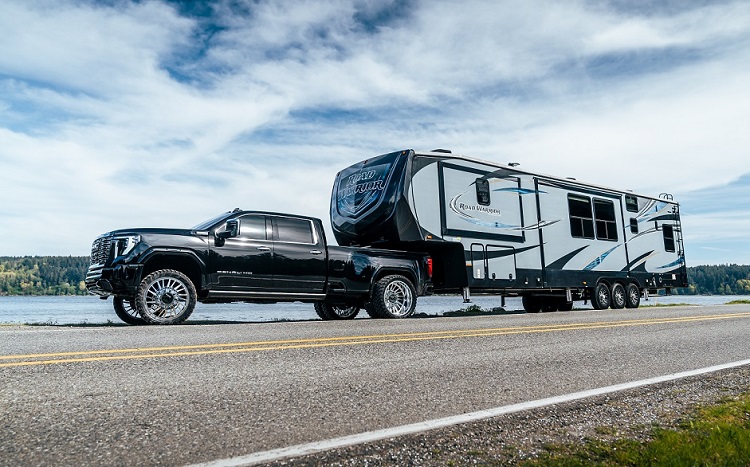
Fifth wheels are a popular type of RV that gets its name from the fifth wheel hitch that connects it to the tow vehicle. This type of gooseneck hitch actually makes towing easier and more stable.
While they’re easier to tow than the typical bumper pull trailer, towing a fifth wheel still involves greatly increasing the weight and overall length of your vehicle, and that means the drive dynamics will be substantially different from what you’re probably used to. Safe RV towing requires some preparation, practice, and removing anything that could turn into a distraction.
Weight
Some of the biggest concerns for anyone who wants to tow a trailer are weight and weight distribution. Weight has a profound effect on the way a vehicle accelerates and decelerates, and it also significantly changes the dynamics of turning.
One of the first things you’ll need to learn is your tow vehicle’s gross combined weight rating (GCWR). This figure is the upper limit of how much weight the vehicle can legally haul and it takes into account the weight of the trailer, the cargo, the other passengers, and the tow vehicle itself. You’ll want to learn this figure for your specific vehicle because it might be lower than you might think. If you’re caught violating this limit, you might be subject to fines or citations. Luckily, you can easily check the gross weight of your trailer and tow vehicle at a weigh station on the highway.
It’s also important to correctly load the weight into your trailer. You want the weight to be evenly distributed from side to side, otherwise, the trailer will turn in an unpredictable way. The weight should also be centered over the front axle. If you do this correctly, there will be about 10-20% of the total trailer weight on the hitch. If there’s too much weight on the hitch, it could cause the front of the tow vehicle to lift off the ground, which will negatively affect your vehicle’s ability to turn and brake.
Preparation
Before you leave, it’s important to take some steps to prepare your trailer and tow vehicle. Basically, you’ll need to make sure everything is in order and try to catch anything that could become a problem later. Check to make sure the trailer is correctly hitched to the tow vehicle with the wiring harnesses securely connected. Check the tire pressure of every tire on the tow vehicle and the trailer. Also, check the turn signals and brake lights, too. Familiarize yourself with the route you plan to travel so that you know what to expect when you get on the road.
Practice
Practice makes perfect, so make sure you practice your driving skills before the real trip. The best way to do this is to head to a safe place to practice with an empty trailer. The empty trailer will be easier to drive around, and if something does happen, you won’t have to worry about damaging the items inside your fifth wheel. A good place to practice is an empty department parking lot. Try to stick within the parking lines to mimic the more complex parking circumstances you might come across.
Cut Out Distractions
Distractions can quickly lead to accidents, so cut out as many as possible. Turn off your phone and let your copilot handle the navigating. You’ll want to leave the music choice and climate control to them, too. Avoid eating while you drive, and try to keep both hands on the wheel at all times.
In conclusion, towing a fifth wheel can be a great way to explore the open road and create lasting memories with your loved ones. However, it’s important to prioritize safety and preparation to ensure a smooth and enjoyable journey. If you’re in need of a fifth wheel or any other RV supplies, consider visiting Oak Lake RV in Moose Lake, MN. Our knowledgeable staff and wide selection of RVs and accessories can help make your next adventure a success. Happy travels!
